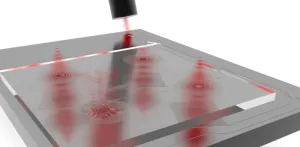(Press-News.org) Wilmer Eye Institute, Johns Hopkins Medicine researchers say they have used artificial intelligence models and machine-learning algorithms to successfully predict which components of amino acids that make up therapeutic proteins are most likely to safely deliver therapeutic drugs to animal eye cells.
The project, a collaboration with researchers from the University of Maryland, holds promise for advancing new and more tolerable drug treatments for common chronic blinding eye diseases, including glaucoma and macular degeneration, which affect 3 million and about 20 million people in the United States, respectively. Current drug therapies for these diseases, consisting of multiple daily eyedrops or frequent eye injections, are effective, but such delivery systems may be difficult to sustain and tolerate over time, and have encouraged scientific efforts to develop delivery systems that would bind to components of eye cells and safely extend the therapeutic impact of the medications they carry.
In 2020, the Food and Drug Administration approved an implantable device that can be placed in the eye and release drugs to treat glaucoma. While that device worked for longer periods than drops or injections, prolonged use was shown in some cases to cause eye cell death, requiring patients to revert to eye drops and injections.
Published May 2 in Nature Communications, the new research showed that artificial intelligence-designed models accurately predicted an effective sequence of amino acids, also known as peptides or small proteins, that would bind to a particular chemical in rabbit eye cells and safely dispense medications over several weeks, reducing the need for frequent, strict treatment schedules. The team specifically investigated peptides that bind to melanin, a compound that provides color to the eye but has the advantage of being widely present throughout specialized structures in eye cells.
The research team noted that other studies investigating drug delivery using peptides have shown how effective this system can be, but they wanted to find peptides that would strongly bind with a widespread eye compound. To do that, the team reasoned that rapid machine learning using artificial intelligence methods could help sort out and predict an effective peptide sequence to try, according to Laura Ensign, Ph.D., the Marcella E. Woll professor of ophthalmology at the Johns Hopkins University School of Medicine, and co-corresponding author of the paper.
The team started by feeding a machine learning model thousands of data points, including characteristics of amino acids and peptide sequences. These data helped the computer model “learn” the chemical and binding properties of certain amino acid combinations, and in time, how to predict candidate peptide sequences for drug delivery using melanin.
The artificial intelligence model generated 127 peptides that were predicted to have varying ability to penetrate the specialized cells that house melanin, to bind to melanin and to be nontoxic to the cells. Out of these 127 peptides, the model predicted that a peptide called HR97 had the highest success rate of binding. The team also confirmed the properties of these peptides, including better uptake and binding within cells as well as no indication of cell death.
To test the model’s prediction, researchers attached HR97 to the drug brimonidine, which is used to treat glaucoma by lowering inner eye pressure, and injected it into adult rabbit eyes. To determine HR97’s performance, researchers measured the levels of brimonidine in the eye cells by testing the cells’ concentrations of the drug after administering the experimental drug delivery system. They found that high amounts of brimonidine were present for up to one month, indicating that HR97 successfully penetrated cells, bound to melanin, and released the drug over a longer period of time. Researchers also confirmed that the eye pressure-lowering effect of brimonidine lasted for up to 18 days when bound to HR97, and found no indication of irritation in the rabbits’ eyes.
Ensign says that future studies using artificial intelligence to predict peptides for drug delivery have huge ramifications for other conditions that involve melanin, and can be extended to targeting other specialized structures.
“We believe we are well on the way to finding solutions in trying to improve patient care and quality of life using drug delivery systems. The ultimate goal is creating something that we can translate out of the lab and actually make people’s lives better,” says Ensign.
Moving forward, Ensign says, researchers will need to find ways to further extend the duration of action, to test the success rate of the AI model’s drug delivery predictions with other drugs, and to determine safety in humans.
Other researchers involved in the study are Henry Hsueh, Usha Rai, Wathsala Liyanage, Yoo Chun Kim, Matthew Appell, Jahnavi Pejavar, Kirby Leo, Charlotte Davison, Patricia Kolodziejski, Ann Mozzer, HyeYoung Kwon, Maanasa Sista, Sri Vishnu Kiran Rompicharla, Malia Edwards, Ian Pitha and Justin Hanes of the Johns Hopkins University School of Medicine; Nicole Anders and Avelina Hemingway of the Johns Hopkins Sidney Kimmel Comprehensive Cancer Center; and Renee Ti Chou and Michael Cummings of the University of Maryland.
This work was supported by funding from the NIH (R01EY026578, R01EY031041, P30CA006973 and S10OD020091), the Robert H. Smith Family Foundation, the Marcella E. Woll and Maryland E-Nnovation Initiative Fund to establish the Marcella E. Woll Professorship in Ophthalmology, Research to Prevent Blindness, a National Eye Institute Training Grant (T32EY007143), a National Science Foundation Award (DGE-1632976) and a National Center for Advancing Translational Sciences grant (UL1TR001079).
END
AI used to advance drug delivery system for glaucoma and other chronic diseases
2023-05-24
ELSE PRESS RELEASES FROM THIS DATE:
Epigenetic profiling identifies potential COPD treatment targets
2023-05-24
Impaired function of lung fibroblast is considered causative for symptoms of the incurable lung disease COPD (Chronic Obstructive Pulmonary Disease). Using high-resolution epigenetic profiling, German and British scientists have now identified potential targets for COPD treatment. The team detected early epigenetic changes in the genome of COPD fibroblasts, providing new insights into the disease pathogenesis and potential therapeutic avenues.
COPD, affecting approximately 600 million people globally, is characterized by chronic inflammation, progressive airway narrowing, and alveolar destruction. Despite its global prevalence, ...
CHOP researchers comprehensively assess the safety of using your head in youth soccer
2023-05-24
Philadelphia, May 24, 2023 – Repeatedly heading a soccer ball has been previously associated with negative long-term brain health for professional players. However, in a new study from researchers at the Minds Matter Concussion Program at Children’s Hospital of Philadelphia (CHOP), a small number of repeated soccer headers equivalent to a throw-in did not cause immediate neurophysiological deficits for teens, suggesting that limited soccer heading exposure in youth sports may not result in irreversible harm if players are properly trained.
The ...
Case study reveals potentially lethal side effects of lecanemab for treatment of Alzheimer's disease
2023-05-24
Amsterdam, May 24, 2023 – In a noteworthy case study published in the Journal of Alzheimer’s Disease investigators report autopsy findings in a 65-year-old woman with Alzheimer’s disease (AD) who received three open label infusions of the experimental anti-amyloid beta (Aβ) antibody drug lecanemab. Four days after the last infusion, she experienced stroke symptoms and died several days later due to multifocal intracerebral hemorrhage despite attempts at therapeutic intervention. Neuropathologic findings reflected ...
How can universities better understand students’ experiences of violence and victimisation?
2023-05-24
Researchers from City, University of London, in collaboration with the University of Surrey, De Montfort University, Universities UK (UUK) and the National Centre (NatCen) for Social Research have conducted the first pilot study into students’ experiences of all forms of violence and victimisation at UK universities.
The Violence at University project, led by Dr Carrie-Anne Myers, Reader in the Department of Sociology and Criminology at City, aimed to investigate whether an effective tool could be developed for tracking when, where and how incidents take place.
Tackling violence and harassment has been high on universities’ agenda for several years. Hate crime has ...
Use of AI: Placebo effect increases risk-taking
2023-05-24
Human augmentation technologies refer to technological aids that enhance human abilities. They include things like exoskeletons, but also augmented reality headsets. A study at the Chair of Human-Centered Ubiquitous Media at LMU has now shown that users have high expectations of the effects of these technologies. As soon as they believe that AI is enhancing their cognitive abilities, they increase their risk-taking. And they do this independently of whether the AI is actually assisting them.
“The hype around AI applications affects the expectations of users. This can lead to riskier behavior,” says Steeven Villa, doctoral researcher ...
Mixing metals for improved performance
2023-05-24
NEWPORT NEWS, VA – A teenage fascination with metals has led to a prestigious early-career award for a superconducting radiofrequency (SRF) materials scientist at the U.S. Department of Energy’s Thomas Jefferson National Accelerator Facility.
Shreyas Balachandran has been chosen to receive the ICMC Cryogenic Materials Award for Excellence, presented annually to an individual under 40 who has demonstrated innovation, impact and international recognition for their work in advancing the knowledge of cryogenic materials.
“It’s ...
SwRI’s Dr. Peter Lee named STLE Fellow
2023-05-24
SAN ANTONIO — May 24, 2023 —Dr. Peter Lee of Southwest Research Institute’s Tribology Research and Evaluations Section has been named a Fellow of the Society of Tribologists and Lubrication Engineers (STLE).
An STLE fellowship recognizes society members with significant contributions over 20 years of active practice in the field of tribology and lubrication engineering. These contributions must meet a standard considered by STLE above and beyond those typically expected of a scientist or engineer. Tribology is the study of lubrication, friction ...
Phytophthora “the plant destroyer” meets its match with a new identification tool
2023-05-24
Known as the “plant destroyer,” the genus Phytophthora is considered one of the most important groups of plant pathogens—causing significant economic and environmental losses throughout history and into today. There are over 200 identified species in the Phytophthora genus. These pathogens, and those yet to be identified, can spread quickly due to the increasing rate of global trade, e-commerce, and travel. Rapid identification is therefore critical for effective plant disease management.
While several international online resources for Phytophthora identification ...
Engineers at UMass Amherst harvest abundant clean energy from thin air, 24/7
2023-05-24
Researchers describe the “generic Air-gen effect”—nearly any material can be engineered with nanopores to harvest, cost effective, scalable, interruption-free electricity
AMHERST, Mass. – A team of engineers at the University of Massachusetts Amherst has recently shown that nearly any material can be turned into a device that continuously harvests electricity from humidity in the air. The secret lies in being able to pepper the material with nanopores less than 100 nanometers in diameter. The research appeared in the journal Advanced Materials.
“This is very exciting,” ...
Multifunctional interface enables manipulation of light waves in free space
2023-05-24
Recent technological advances have given us a remarkable ability to manipulate and control light waves, opening up numerous applications in various fields, such as optical communication, sensing, imaging, energy, and quantum computing. At the heart of this progress are photonic structures that can control light waves, either at the chip level in the form of photonic integrated circuits (PICs) or in free space as meta-optics. Combining these structures allows for the creation of compact optical systems. The PICs can be used to make subtle changes to the light wave, ...





